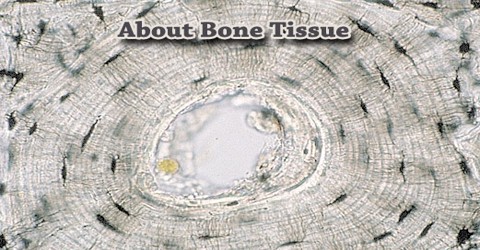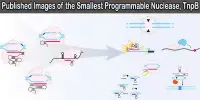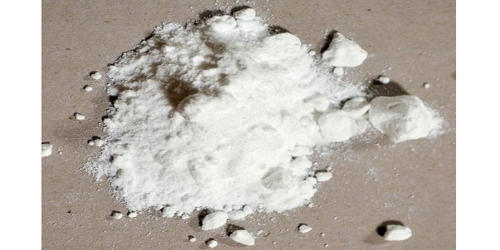About Bone Tissue
Definition
Bone Tissue is a type of connective tissue of vertebrates. Other types of connective tissues are cartilage, loose, and dense connective tissues. Bone tissues are the type of connective tissue that is hardened or become rigid due to mineralization. The bone tissue forms the skeleton of the vertebrates.
Bones are organs that are made up of bone tissue as well as bone marrow, small blood vessels, epithelium and nerves. Bone tissue refers specifically to the bone mineral matrix that forms the rigid sections of the organ, and the bone cells within it. The two types of bone tissue are cortical bone and cancellous bone. There is another kind of tissue called subchondral bone which underlies the epiphyseal cartilage at the ends of bones.

The bone tissue is comprised of the bone matrix as well as the bone cells. The bone matrix is the extracellular matrix of the bone. It is comprised of organic and inorganic substances. The organic component of the bone matrix includes the collagen and ground substance whereas the inorganic component is the inorganic bone salts, mainly hydroxyapatite. Bone tissues consist of collagen fibers and ground substance containing calcium, magnesium, and phosphate ions that chemically combine and harden into a mineral, hydroxyapatite. The combination of hard mineral and flexible collagen makes bone harder than cartilage without being brittle.
The bones themselves are formed from several different connective tissues, including:
- Bone (called “Osseous”) tissue,
- Periosteum,
- Red Bone Marrow,
- Yellow Bone Marrow, and
- Endosteum
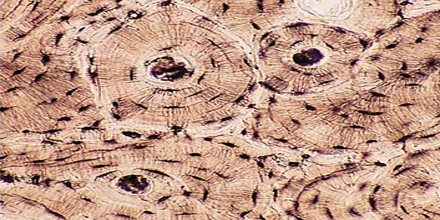
Bone Connective Tissue
Connective tissue is defined as a tissue that supports and/or connects our body together in some way. Bone connective tissue provides structural support for other tissues such as our muscles and skin. It’s a little strange to think of bone as a living tissue, but that’s exactly what it is. Bones are constantly being damaged and rebuilt throughout the course of our lives, just like a tower of blocks. Think about how much stress we put on our bodies on a daily basis – we need to have some way to repair small injuries to our bones, otherwise we would all be walking around in casts all the time. There are several different structures and types of cells that make up bone connective tissue we can examine to understand how this tissue works.
Structure and Function of Bone Tissue
There are two main types of bone tissue, compact bone and spongy bone. Individual bones in the body can be formed from both of these types of bone tissue. The diagram on the right shows the physical structure of a typical “long bone”.
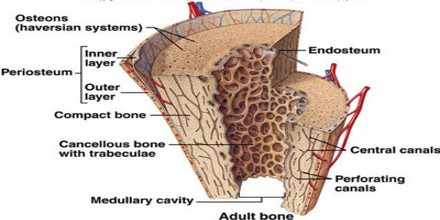
Cortical bone – Cortical bone, synonymous with compact bone, is one of the two types of bone tissue that form bones. Cortical bone forms the extremely hard exterior of bones. Cortical bone facilitates bone’s main functions: to support the whole body, protect organs, provide levers for movement, and store and release chemical elements, mainly calcium. As its name implies, cortical bone forms the cortex, or outer shell, of most bones. Cortical (compact) bone is much denser than cancellous bone.
Cancellous bone – Cancellous bone is synonymous with trabecular or spongy bone. Cancellous bone has a higher surface area to mass ratio than cortical bone because it is less dense. This makes it softer, and weaker but more flexible. The greater surface area also makes it suitable for metabolic activities such as the exchange of calcium ions. Cancellous bone is typically found at the ends of long bones, near to joints and within the interior of vertebrae. Cancellous bone is highly vascular and frequently contains red bone marrow where haematopoiesis, the production of blood cells, occurs. The primary anatomical and functional unit of cancellous bone is the trabecula.
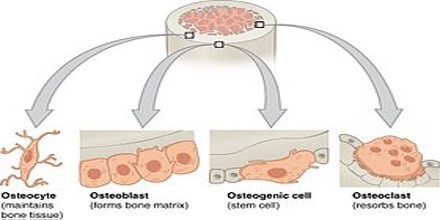
Bone tissue performs numerous functions including:
- Responding to maintain the body’s proper pH levels. In response to acidic conditions bone tissue will dissolve to release neutralizing calcium carbonate into the bloodstream.
- Bone remodeling also called bone metabolism a process that includes following Wolff’s law.
- Support for muscles, organs, and soft tissues.
- Leverage and movement.
- Protection of vital organs, e.g., the heart.
- Calcium phosphate storage.
- Hemopoiesis – formation of blood cells by the bone marrow interspersed within the spongy bone.
The increasing knowledge about the structure and functions of bone cells contributed to a better understanding of bone biology. It has been suggested that there is a complex communication between bone cells and other organs, indicating the dynamic nature of bone tissue.
